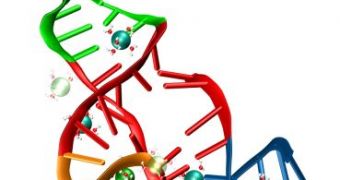Researchers at the Department of Energy's Oak Ridge National Laboratory, Center for Molecular Biophysics, are using the latest technology to find out the potential role of nucleic acids in the creation of life.
Supercomputer simulations of molecular dynamics allowed team leader Jeremy Smith director of the ORNL's Center for Molecular Biophysics and Governor at University of Tennessee, to experiment an organic reaction that could have been crucial to the development of the RNA (ribonucleic acids) into early life forms.
Because there are certain types of RNA, called ribozymes, that can store genetic data and also catalyze chemical reactions, the scientists analyzed the lab-grown ribozyme that catalyzes the Diels-Alder reaction.
These features are necessary to the formation of life, as “life means making molecules that reproduce themselves, and it requires molecules that are sufficiently complex to do so,” according to Smith.
“If a ribozyme like the Diels-Alderase is capable of doing organic chemistry to build up complex molecules, then potentially something like that could have been present to create the building blocks of life.”
The Diels-Alder ribozyme needs magnesium in order to work, and the researchers found a theoretical explanation to why this is happening, thanks to computer models that gave insight to the finest details of the reaction.
According to Smith, their calculations revealed that inside the ribozyme there was a “mouth” that opened and closed, thus controlling the reaction, and the magnesium concentration had a direct impact on the ribozyme's movements.
“When there's no magnesium present, the mouth closes, the substrate can't get in, and the reaction can't take place,” explained Smith.
“We found that magnesium ions bind to a special location on the ribozyme to keep the mouth open,” he added.
Computer simulations are the only way to see inside biological systems and since these structures are constantly changing, this is the only way to understand them, said the scientist.
This research was published in the Journal of the American Chemical Society, under the title 'Magnesium-Dependent Active-Site Conformational Selection in the Diels-Alderase Ribozyme'.
The research team included Tomasz Berezniak and Mai Zahran, as well as Petra Imhof and Andres Jäschke from the University of Heidelberg, and the research was supported by Laboratory Directed Research and Development program funding.

 14 DAY TRIAL //
14 DAY TRIAL //